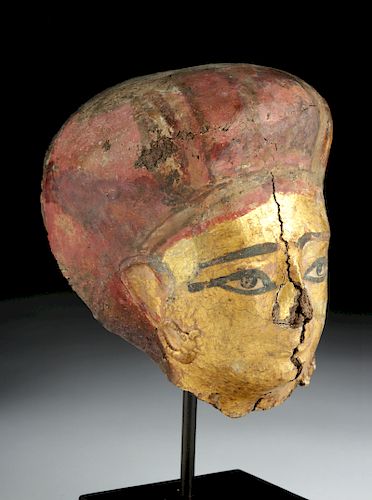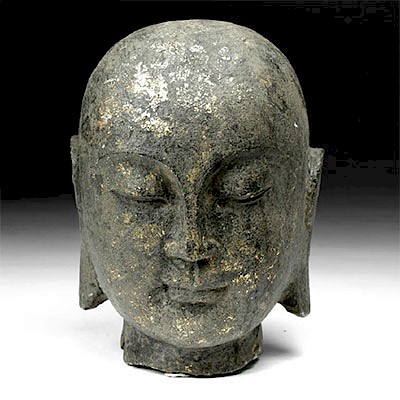Romano-Egyptian Gilded Cartonnage Mask
Lot 3
About Seller
Artemis Fine Arts
686 S Taylor Ave, Ste 106
Louisville, CO 80027
United States
Selling antiquities, ancient and ethnographic art online since 1993, Artemis Gallery specializes in Classical Antiquities (Egyptian, Greek, Roman, Near Eastern), Asian, Pre-Columbian, African / Tribal / Oceanographic art. Our extensive inventory includes pottery, stone, metal, wood, glass and textil...Read more
Estimate:
$3,000 - $4,000
Absentee vs Live bid
Two ways to bid:
- Leave a max absentee bid and the platform will bid on your behalf up to your maximum bid during the live auction.
- Bid live during the auction and your bids will be submitted real-time to the auctioneer.
Bid Increments
| Price | Bid Increment |
|---|---|
| $0 | $25 |
| $300 | $50 |
| $1,000 | $100 |
| $2,000 | $250 |
| $5,000 | $500 |
| $10,000 | $1,000 |
| $20,000 | $2,500 |
| $50,000 | $5,000 |
| $100,000 | $10,000 |
| $200,000 | $20,000 |
About Auction
By Artemis Fine Arts
Nov 29, 2018
Set Reminder
2018-11-29 10:00:00
2018-11-29 10:00:00
America/New_York
Bidsquare
Bidsquare : Holiday Glitz - Ancient / Ethnographic Art
https://www.bidsquare.com/auctions/artemis-gallery/holiday-glitz---ancient-ethnographic-art-3672
What to give this holiday season? Think silver, gold, bronze, shiny, glittery, wearable, festive. We ship worldwide and handle all shipping in-house for your convenience. This is one sale you don't want to miss! Artemis Fine Arts info@artemisgallery.com
What to give this holiday season? Think silver, gold, bronze, shiny, glittery, wearable, festive. We ship worldwide and handle all shipping in-house for your convenience. This is one sale you don't want to miss! Artemis Fine Arts info@artemisgallery.com
- Lot Description
Egypt, Ptolemaic to early Roman period, ca. 332 BCE to 100 CE. A gorgeous gilded cartonnage sarcophagus mask displaying quintessential Egyptian beauty, made from layers of plaster-covered papyrus and painted with bright pigments. The face is defined by fine black-painted eyes and brows, arching ears lined in red pigment and adorned with stylized Apis bull earrings, full lips in an enigmatic smile, and a smooth brow line, all enveloped in thin layers of gold leaf. Traces of the original lappets extend behind each ear and would perhaps have displayed rich iconograpic deities such as Horus, Anubis, and Osiris. A simple pink headdress is embellished with two pairs of cream-hued vertical bands leading up to a hemispherical top section. The verso is concave enough to fit over the head of a linen-wrapped mummy. A fantastic example that exudes a sense of human life even though it belongs to this funerary tradition. Custom wooden display stand included. Size: 6.25" W x 7.5" H (15.9 cm x 19 cm); 10.375" H (26.4 cm) on included custom stand.
Ancient Egyptians believed it was of the utmost importance to preserve a body of the deceased, because the soul needed a place to reside after the death. Preservation of the body was done via mummification - a process involving the removal of internal organs that were placed in canopic jars, wrapping body in linen, and then embalming. Death masks like this example were created so that the soul could recognize the body and return to it. For this reason, death masks were made in the relative likeness of the deceased.
Artisans were able to employ the use of different materials when crafting sarcophagi or any elements to be placed atop the deceased. Earlier masks were carved from wood, while later ones were made of cartonnage, a material made from papyrus or linen and soaked in plaster which was then applied to a wooden mold. Royal death masks, perhaps the most famous being that of Tutankhamen, were made from precious metals. All death masks were intended to resemble the deceased subject; however, eyes were always slightly enlarged and lips presented in a subtle smile, as we see in this example.
A stylistically similar example (though more complete) hammered for GBP 25,000 ($33,378.88) at Christie's, London Antiquities Auction (sale 12240, December 6, 2016, lot 16): https://www.christies.com/lotfinder/ancient-art-antiquities/an-egyptian-gilt-cartonnage-mummy-mask-ptolemaic-6041259-details.aspx?from=searchresults&intObjectID=6041259&sid=991b487f-1b3d-4320-8452-269680a15e4a
Provenance: private New York, New York, USA collection; ex-private old collection of an art history professor, Tenafly, New Jersey, USA
All items legal to buy/sell under U.S. Statute covering cultural patrimony Code 2600, CHAPTER 14, and are guaranteed to be as described or your money back.
A Certificate of Authenticity will accompany all winning bids.
We ship worldwide and handle all shipping in-house for your convenience.
#133721Significant fissure to face with small repairs and losses to nose. Old restoration to much of proper left side and top of head. Surface wear and abrasions commensurate with age as expected, losses to face, head, neck line, and peripheries, with waxy substance along bottom of verso, chipping and fading to pigmentation, and loss to some gilding. Nice encrustation along verso, and nice earthen deposits throughout.Condition
- Shipping Info
-
All shipping is handled in-house for your convenience. Your invoice from Artemis Gallery will include shipping calculation instructions. If in doubt, please inquire BEFORE bidding for estimated shipping costs for individual items.
-
- Buyer's Premium



 EUR
EUR CAD
CAD AUD
AUD GBP
GBP MXN
MXN HKD
HKD CNY
CNY MYR
MYR SEK
SEK SGD
SGD CHF
CHF THB
THB
















